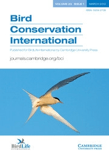
BIRD CONSERVATION INTERNATIONAL
Scope & Guideline
Championing the preservation of bird species and their habitats.
Introduction
Aims and Scopes
- Avian Conservation and Ecology:
The journal emphasizes research that investigates the conservation status and ecological needs of bird species, particularly those that are threatened or endangered. - Population Monitoring and Trends:
A core area of focus is on studying bird populations through various methodologies, including citizen science, to assess trends and inform conservation strategies. - Habitat Assessment and Management:
Research often explores habitat requirements and the impact of environmental changes on bird populations, providing insights for habitat restoration and management efforts. - Impact of Human Activities:
The journal addresses the consequences of human-induced factors such as habitat loss, climate change, and pollution on bird species and their habitats. - Innovative Research Methodologies:
BIRD CONSERVATION INTERNATIONAL promotes the use of advanced methodologies, including GPS tracking, acoustic monitoring, and habitat modeling, to enhance conservation efforts. - Community Engagement and Conservation:
The journal recognizes the role of local communities and citizen science in bird conservation, highlighting collaborative approaches to monitoring and managing bird populations.
Trending and Emerging
- Climate Change Impacts:
Research focusing on the effects of climate change on bird distributions, breeding patterns, and habitat suitability has gained significant traction, underscoring the urgency of understanding these impacts for conservation. - Citizen Science and Data Utilization:
There is a growing trend in utilizing citizen science data for monitoring bird populations, reflecting a shift towards collaborative and community-driven conservation efforts. - Technological Advancements in Monitoring:
The use of modern technologies, such as GPS tracking and acoustic monitoring, has become increasingly prominent, offering new insights into bird movement and behavior. - Invasive Species Management:
Studies addressing the impact of invasive species on native bird populations and ecosystems have emerged as a critical area of research, highlighting the need for effective management strategies. - Habitat Restoration and Connectivity:
Increasing attention is being given to habitat restoration initiatives and the importance of habitat connectivity for bird populations, emphasizing landscape-level conservation approaches. - Ecosystem Services and Bird Conservation:
Research exploring the role of birds in ecosystem services and their contributions to biodiversity and ecosystem health is becoming more prominent, linking avian conservation to broader environmental goals.
Declining or Waning
- Traditional Conservation Methods:
There appears to be a decreasing emphasis on traditional conservation methods, such as simple habitat preservation, as researchers increasingly explore innovative and integrative approaches. - Broader Ecological Studies:
Research that broadly examines ecosystems without a specific focus on birds is becoming less frequent, as the journal prioritizes studies that directly link to avian conservation. - Species-Specific Management Strategies:
While species-specific studies remain crucial, there has been a gradual decline in publications focused solely on individual species management without considering broader ecological contexts. - Conservation Policy Analysis:
Discussions centered on conservation policy frameworks and governance have become less prevalent, indicating a shift towards more empirical research and field studies.
Similar Journals

Birds
Bridging disciplines for a deeper understanding of birds.Birds, published by MDPI, serves as a pivotal platform for scholarly exchange in the fields of Animal Science, Zoology, and Ecology. With its publication journey from 2020 to 2024, the journal notably holds a Q2 ranking in both the Animal Science and Zoology, and Ecology, Evolution, Behavior and Systematics categories for 2023, indicating its growing influence and relevance in these critical areas of study. Hailing from Switzerland, Birds is committed to advancing understanding of avian biology and ecology, offering timely research findings and fostering interdisciplinary collaboration. The journal features an Open Access model, allowing unimpeded access to high-quality research and facilitating greater dissemination of knowledge. Aspiring researchers, seasoned professionals, and students alike will find a wealth of insights and innovative approaches within its pages, contributing significantly to the conservation and appreciation of bird species worldwide.

Avian Conservation and Ecology
Advancing avian science for a sustainable future.Avian Conservation and Ecology, published by the Resilience Alliance, is a premier open-access journal dedicated to advancing the scientific understanding and management of avian populations and their ecosystems. With an ISSN of 1712-6568, this journal has been a vital resource since its inception in 2005, ensuring that research findings are readily accessible to the global community. Based in Canada, it covers a diverse array of topics within the realms of Animal Science, Zoology, Ecology, and Conservation. Recognized for its rigor, it boasts a distinguished Q1 ranking in Animal Science and Zoology, and maintains respectable positions in various ecological categories as of 2023. Researchers and students alike will find valuable insights and innovative studies that address key conservation challenges, reflecting the journal's commitment to fostering ecological resilience and informing policy-making. As a platform that champions open access, Avian Conservation and Ecology plays a crucial role in enhancing collaboration and communication among scientists, policy-makers, and the public。
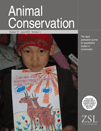
ANIMAL CONSERVATION
Empowering Research for a Sustainable Future.Animal Conservation is a prestigious journal that serves as a vital platform for the dissemination of research dedicated to the preservation of wildlife and habitats. Published by Wiley, this journal has established a significant presence in the fields of Ecology and Nature and Landscape Conservation, holding a distinguished Q1 category ranking for both in 2023. With an impressive Scopus rank of #25 in the realm of environmental science, it caters to a global audience keen on understanding and addressing pressing conservation issues. The journal provides researchers, professionals, and students with high-quality, peer-reviewed articles that explore innovative methods and strategies in animal conservation. With its continuous publication since 1998, encompassing a comprehensive range of topics, Animal Conservation is indispensable for anyone aiming to make impactful contributions to the field of ecology and conservation biology.

MALIMBUS
Elevating ornithological knowledge for a sustainable future.MALIMBUS is a peer-reviewed journal published by the West African Ornithological Society, focusing on the study of avian biology and conservation. It aims to disseminate important research findings that contribute to the understanding of bird species, their habitats, and the challenges they face across West Africa and beyond. Although currently not available in an open-access format, the journal is an invaluable resource for ornithologists, ecologists, and industry professionals keen on advancing their understanding of avian science. Those engaged in research on bird migration, breeding behaviors, and conservation strategies will find MALIMBUS to be a vital platform for sharing innovative ideas and fostering collaborations. With its commitment to quality and rigorous review processes, MALIMBUS is an essential reference for anyone dedicated to studying and preserving avian diversity.

AMPHIBIAN & REPTILE CONSERVATION
Fostering Collaboration for a Sustainable FutureAMPHIBIAN & REPTILE CONSERVATION, published by the Amphibian Conservation Research Center & Lab, is a leading journal dedicated to the field of herpetology and environmental conservation. With an ISSN of 1083-446X and an E-ISSN of 1525-9153, this journal serves as a vital resource for researchers, conservationists, and students interested in the preservation of amphibian and reptile species. The journal has achieved remarkable rankings, categorized in the Q2 quartile for Animal Science and Zoology, Ecology, and Nature and Landscape Conservation as of 2023, reflecting its significant contribution to the scientific community. Over the converged years from 2016 to 2024, the journal has established itself as an integral platform for disseminating research findings, fostering collaboration, and enhancing the understanding of biodiversity and ecosystem dynamics. By embracing an open-access approach, AMPHIBIAN & REPTILE CONSERVATION ensures that critical research is readily available to a global audience, promoting informed conservation efforts and policy advocacy to safeguard these vital species amidst their declining populations.

JOURNAL OF ORNITHOLOGY
Unveiling Insights into Avian EcologyJOURNAL OF ORNITHOLOGY, published by Springer Heidelberg, is a leading international journal dedicated to the study of birds and their conservation. With an ISSN of 2193-7192 and an E-ISSN of 2193-7206, this journal serves as a crucial platform for disseminating innovative research focused on avian biology, ecology, and behavior, making significant contributions to the fields of Agricultural and Biological Sciences and Animal Science and Zoology, where it holds a commendable rank of #156 out of 490 in Scopus. Established from 2004 and continuing through 2024, the journal strives not only to advance academic scholarship but also to inform practical conservation efforts globally. While currently not open access, it remains a vital resource for researchers, professionals, and students seeking high-quality studies and findings that influence the understanding and preservation of bird species. The journal's commitment to excellence in science highlights its importance in ornithological research, offering insights that are both profound and actionable.

Global Ecology and Conservation
Pioneering research in the heart of conservation efforts.Global Ecology and Conservation, published by Elsevier, stands as a premier open-access journal dedicated to advancing the field of ecology and conservation science. Since its inception in 2014, the journal has facilitated the dissemination of high-quality research, fostering critical dialogue on ecosystem management, biodiversity preservation, and sustainability practices across the globe. With a remarkable ranking within the top quartiles (Q1) in various categories including Ecology, Evolution, Behavior and Systematics, and Nature and Landscape Conservation, it is positioned among the leading resources for researchers and professionals alike. The journal has garnered a notable impact, ranking #65 out of 721 in Ecology, and houses articles that are vital to understanding and addressing the pressing environmental challenges of our time. Available in an open-access format, researchers can freely access and share vital findings, promoting a collaborative approach to ecological research. Global Ecology and Conservation is not just a publication; it is a critical tool for innovation and advocacy in conservation, poised to inspire the next generation of environmental stewards.
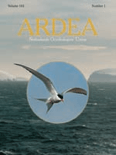
ARDEA
Fostering collaboration in animal science and ecology.ARDEA, published by the Nederlandse Ornithologische Unie, is a prominent journal in the fields of Animal Science, Zoology, and Ecology. With its rich history spanning from 1981 to the present, ARDEA serves as a vital platform for researchers and professionals dedicated to avian studies and the ecological sciences. This quarterly journal is recognized in the Q3 category for both Animal Science and Ecology, as per the latest rankings, and maintains an impressive global standing within its subject areas. Although it operates without an open access model, the journal provides significant insights and contributions to the understanding of bird biology, conservation, and evolution. Researchers and students seeking to advance their knowledge in ornithology and related fields will find ARDEA to be an indispensable resource, promoting high-quality research and fostering academic collaboration.
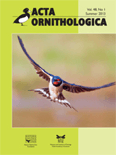
ACTA ORNITHOLOGICA
Elevating the study of birds through rigorous research and collaboration.ACTA ORNITHOLOGICA is a prominent peer-reviewed journal dedicated to advancing the field of ornithology. Published by the MUSEUM & INST ZOOLOGY in Poland, the journal focuses on a wide array of topics related to avian biology, ecology, and conservation, supporting the dissemination of high-quality research aimed at understanding bird populations and their habitats. With a respectable impact factor reflected in its Q3 rank within the fields of Animal Science and Zoology, ACTA ORNITHOLOGICA stands as a reliable source for professionals and academics alike. The journal is indexed in major databases like Scopus, further contributing to its visibility and accessibility to scholars worldwide. Engaging with this journal provides researchers and students with invaluable insights and opportunities to contribute to the growing body of knowledge in ornithological studies as it continues to maintain its commitment to excellence and relevance in the scientific community from its inception in 1981.
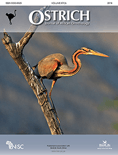
OSTRICH
Pioneering Research for Conservation and BiodiversityOSTRICH, a distinguished journal published by Taylor & Francis Ltd, serves as a pivotal platform for disseminating research in the fields of ecology, evolution, behavior, and systematics. With an ISSN of 0030-6525 and an E-ISSN of 1727-947X, this journal has been contributing vital insights to the scientific community since its inception in 1930. Maintained in the UK, OSTRICH holds a respectable Q3 category ranking in the 2023 Ecology, Evolution, Behavior, and Systematics quartiles and ranks 408th out of 721 within its scientific domain according to Scopus, showcasing a competitive position within the 43rd percentile. OSTRICH is committed to publishing high-quality research that informs conservation efforts and biodiversity studies, making it an essential resource for researchers, professionals, and students interested in avian biology and related ecological fields. While not currently an open-access journal, OSTRICH offers varied access options through institutions and libraries, further widening its reach and impact within the scientific community. We invite academics and practitioners to explore its valuable articles that drive forward innovations in avian research.